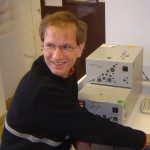Link to Pubmed [PMID] – 19695228
Biochem. Biophys. Res. Commun. 2009 Nov;389(1):10-5
Increased vascular permeability and vasodilation are responses usually elicited by snake envenomation. In this report, we isolated from Macroviperalebetina venom two protein groups designated IC1 (Increasing Capillary1) and IC2 based on their activities on capillary permeability. Mass spectrometry analysis showed that IC1 contained four major proteins of 23,650, 24,306, 24,589 and 24,718Da, whereas IC2 contained three major proteins of 25,101, 25,194 and 25,298Da. N-terminal amino-acid sequencing revealed that IC1 and IC2 belong to the snake venom VEGF (svVEGF) family. IC1 and IC2 had a marked specificity for VEGFR-2, with affinities in the nanomolar range. Interestingly, they also bind to NRP1 and NRP2, with affinities in the micromolar range. This is the first report demonstrating that M. lebetina encodes several distinct svVEGFs, endowed with a capacity to interact with neuropilins. IC1 and IC2 could be valuable tools to understand the molecular properties of angiogenic factors and their receptors.

